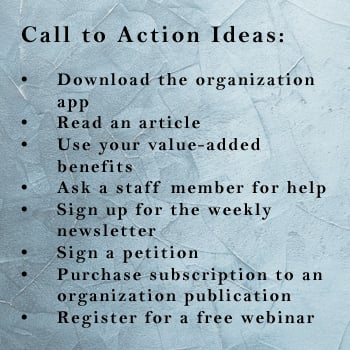Gauging Member Engagement: Segmented Member Marketing for Success
Last week, we outlined the process for calculating an actionable number to describe each member’s level of engagement in the article, Gauging Member Engagement: How to Collect Actionable Data. In part 2 of the series below, we describe how to take this new metric and customize a member marketing plan.
Ideally, you’ve followed the steps outlined in part 1 of this series. This process of assigning values to member interactions (which add up to a total engagement score) will give you a valuable metric by which you can segment your members.
Even if you haven’t, any amount of member data is enough to get you started. In fact, each member’s length of membership, age, gender and other demographic data gives you a great starting point.
Below, we take you through the steps you need to create truly customized marketing plans that let you communicate with each member on their level.
- Segment with available demographics
- Further segment by engagement score
- Customize membership marketing plans
- Re-evaluate based on results

As you go through these steps, remember that any work you put in now will be rewarded with deeper emotional connections with your members which helps lead to higher levels of retention, more member referrals, higher conversions of potential members to paying members and more.
How to Segment with Available Demographics
People love a personalized experience. Don’t believe me? Check out just a few of the many engagement statistics we’ve curated on the subject:
- When personalization is done well, there is a 6.4x lift in member satisfaction with the loyalty program
- 80% of consumers indicated they are more likely to do business with a company if it offers personalized experiences
- 93% of businesses with advanced personalization strategies increased their revenue last year
- 54% of customers are willing to share personal information with companies if it will be used to create a personalized experience
It’s clear that when members feel like you know them and care about their wants and needs, they respond in kind.
So how do you give them this customized experience? Unfortunately there isn’t one marketing message to rule them all. The easiest place to start is looking at what you already know about your membership. If you know names, program your emails to address the members personally. If you know length of membership, then separate the new members who probably need basic tutorials, from the seasoned veterans who would be more likely to respond to a deeper message.
If you know their age, gender, median income and other demographics, then you can look to trends others have found. Luckily, many studies have published their findings regarding what different demographic groups tend to want from the businesses they associate with.
And when you group like people together according to common needs and similar response to marketing efforts, it’s called segmenting. Segmentation is a well-established best practice used at least to some degree by organizations of all sizes.

To segment your members, first decide which demographics matter. Ask yourself, which groups are different enough from each other in terms of needs and marketing response, to warrant different marketing plans? Also ask, how many customized marketing plans am I prepared to create?
Segmenting based on demographic information is a step in the right direction. But you can take it to an entirely different level by adding in the engagement scores you calculated earlier.
How to Further Segment by Engagement Score
Demographics will help you understand group averages. But many organizations find that the real magic happens when they start using engagement scores too. That’s because engagement scores help you get closer to understanding individuals, and lead them on their own personal journey.
![]()
 Remember the idea of the ladder of engagement? Members start their journey on the bottom rung, mostly by participating in small and easy ways like opening an email or liking a post. The idea is to encourage members to climb the ladder, and join your most loyal members who feel true emotional connection with you.
Remember the idea of the ladder of engagement? Members start their journey on the bottom rung, mostly by participating in small and easy ways like opening an email or liking a post. The idea is to encourage members to climb the ladder, and join your most loyal members who feel true emotional connection with you.
This ladder helps many organizations visualize effective marketing plans for each group of members. That’s because you can’t expect members to jump straight to the top, but rather to climb the rungs one at a time, deepening your relationship with each step.
This is where a good CRM will be an invaluable resource. It can track members as their points accumulate with each new interaction. Once they’ve reached a certain threshold (metaphorically climbing to the next rung), the CRM will move them to their new marketing group. There, they will receive a fresh set of messages aimed at getting them to the next step up.
The best thing about this system is that you can actually watch your members become more engaged. You’ll be able to see those with lower scores respond to your personalized messages, interact more and grow their score.
Once you’ve sorted your members onto the rungs, it’s time to decide just what message will get them climbing.
How to Customize Membership Marketing Plans
Customized marketing plans aimed at getting members to take specific actions are one of the fastest and most effective ways to build a relationship with your members. That’s because your messages will feel personalized to them specifically, with a call to action that is the natural next step in their member journey.
For example, you might be very appropriate to ask members at the top of the ladder to invest in a conference. These members already trust your value. However, if you ask new or barely-participating members to spend more when they’re barely using your other services, you run the risk of this message looking like a money grab or exploitation of their membership.
It’s much better to encourage members who are just starting up the ladder to perform a simple action. Once they’ve accomplished that, you ask them to do something a little bigger.
 But how do you decide what you want them to do? Well, this is where a points system comes in handy. If you’ve already designated some actions as more important for member success, then start with the easiest ones and go from there. Have an awesome member onboarding sequence? This is another place to look for essential actions. Your sequence of calls to action will be unique to your membership and organization needs.
But how do you decide what you want them to do? Well, this is where a points system comes in handy. If you’ve already designated some actions as more important for member success, then start with the easiest ones and go from there. Have an awesome member onboarding sequence? This is another place to look for essential actions. Your sequence of calls to action will be unique to your membership and organization needs.
Keep in mind that the number of groups you break your members in to will need to make sense given the size of your organization and the level of support you have available to dedicate to this effort. It sounds great in theory to create an individual plan for customized for the 35 year old males who have been members for 4.5 years, who prefer to receive weekly emails and have used their membership discount program twice. But if there’s only one person that meets those strict specifications, you’re only making more work for yourself than you need to.
Hint: many organizations have found great success creating a series of marketing plans for potential members, with the last step being paid membership.
Re-evaluate Based on Results
By the time you get to the last step, you’ll have learned a lot about your membership. Enough in fact, that it’s time to start the process over from the beginning. If you find a hole in your data, make a plan to fill it. Your equation can only benefit from additional influential factors. If you find you misjudged the importance of certain actions, you can revamp your equation to better reflect your unique membership.
For even faster results, make sure you’re tracking member reactions to your marketing. Some organizations find measurable results with A/B testing, where your message is identical except for one change. This is useful to help you determine whether one strategy is stronger than another.
In fact, it would be smart to revisit these steps periodically going forward. As a review, here they are again from the beginning:
- Measure member participation
- Measure member relationship
- Assign values to member interactions
- Segment with available demographics
- Further segment by engagement scores
- Customize membership marketing plans
Not only is your membership changing as people come and go, organizations are getting more and more sophisticated in viewing data and analyzing what action lead to more engagement. As the ways in which businesses interact with their constituents evolve, you’ll want to ensure you’re not being left behind.
It may be an imperfect art, but every step you take will get you closer to reaching your organization’s goals. Or better yet, blow your goals out of the water and go on to make even more aggressive goals.
So what are you waiting for? You can put a number on engagement to help you understand what is going on with your membership. And you can use that number to better communicate value to each individual. After all, understanding is the first step to improving. And who doesn’t want increased profitability and more loyalty at the end of the day?
Related articles:
Three of the Most Influential Factors When it Comes to Loyalty
What is Member Engagement and Why Your Membership Growth Depends on it
Topics: Customer Engagement, Discount Programs, member retention, member engagement, Membership Organizations, loyalty programs, member loyalty

Written by: Kendra Lusty











Share your Comment.